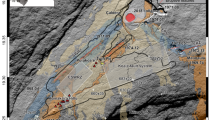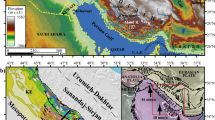Abstract
The palaeo-intensities (F a) of the geomagnetic field in Egypt at some ages are determined by archaeomagnetic measurements and found to be:F a=36.2 μT at 3100 B.C., Fa=46.8 μT at 3000 B.C.,F a=36.5 μT at 2780 B.C., 49.0 μT at 2500 B.C., 36.4 μT at 2200 B.C., 57.5 μT at 1990 B.C., 62.1 μT atca 1400 B.C., 61.5 μT at 1400 B.C., 69.9 μT at 600 B.C., 59.3 μT at 550 B.C., 79.9 μT at 460 B.C., 73.7 μT at 450 B.C., 69.7 μT at 320 B.C., 56.2 μT at A.D. 50, 64.9 μT, at A.D. 400, 54.4 μT at A.D. 300, 57.5 μT at A.D. 700 and 43.0 μT at A.D. 1975.
The palaeo-inclinations (I a) at some ages are found to be:I a=24.2° at 420 B.C., 44° at A.D. 50, 60.7° at A.D. 703 and 42° at A.D. 1795.
The measured values ofF a are affected by the anisotropy of magnetic susceptibility of the samples by 13% to 20% of the expected correct value. The suitable correction of this effect is by multiplyingF ⊥ by 1/((1+0.2(θ/90)) andF ∥ by 1/((1–0.13 (θ/90)), whereF ⊥ andF ∥ are the resultant values ofF a if the laboratory field is perpendicular or parallel to the wall of the sample during the Thelliers' experiments, respectively, and θ is the angle between the direction of natural remnant magnetization of the sample and the direction of the laboratory field.
The results of this paper, together with the previous results for Egypt and the neighbourhoods, lead to the production of the secular variation curve of the geomagnetic field in Egypt for the last 5000 years. The intensity of the field shows a periodicity of about 400 years with multiples.
Similar content being viewed by others
References
Aitken, M. J., Allsop, A. L., Bussel, G. D. and Winter, M. B. (1984),Geomagnetic intensity in Egypt and Western Asia during the second millennium B.C. Nature310, 205–206.
Athavale, R. M. (1969),Intensity of the geomagnetic field in prehistoric Egypt. Earth Planet. Sci. Lett.6, 221–224.
Bucha, V. (1967),Intensity of the Earth's magnetic field during archaeological times in Czechoslovakia. Archaeom.10, 12–25.
Fahim, M. andHussain, A. G. (1977),The secular variation of the geomagnetic field at Helwan, Egypt. Helw. Instit. Astr. Geophys. Bull.139, 1–19.
Fox J. M. W. andAitken M. J. (1980),Cooling-rate dependence of thermoremnent magnetization. Nature283, 462–463.
Hussain, A. G. (1983),Archaeomagnetic investigations in Egypt: Inclination and field intensity determinations. J. Geophys.53, 131–140.
Rogers, J., Fox, J. M. W. andAitken, M. J. (1979),Magnetic anisotropy in ancient pottery. Nature277, p. 644.
Thellier, E. andThellier, C. (1959),Sur l'intenite du champ magnetique terrestre dans le passe historique et géologique. Ann. Geophys.,15, 185–376.
Walton, D. (1982),Errors and resolution of thermal technique for obtaining the geomagnetic intensity, Nature295, 512–515.
Wienert, K. A. (1970),Notes on geomagnetic observatory and survey practice, Unesco, printed in Belgium.
Author information
Authors and Affiliations
Rights and permissions
About this article
Cite this article
Hussain, A.G. The secular variation of the geomagnetic field in Egypt in the last 5000 years. PAGEOPH 125, 67–90 (1987). https://doi.org/10.1007/BF00878614
Received:
Revised:
Accepted:
Issue Date:
DOI: https://doi.org/10.1007/BF00878614




